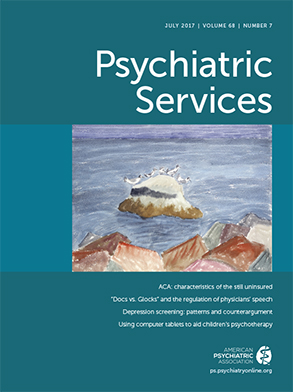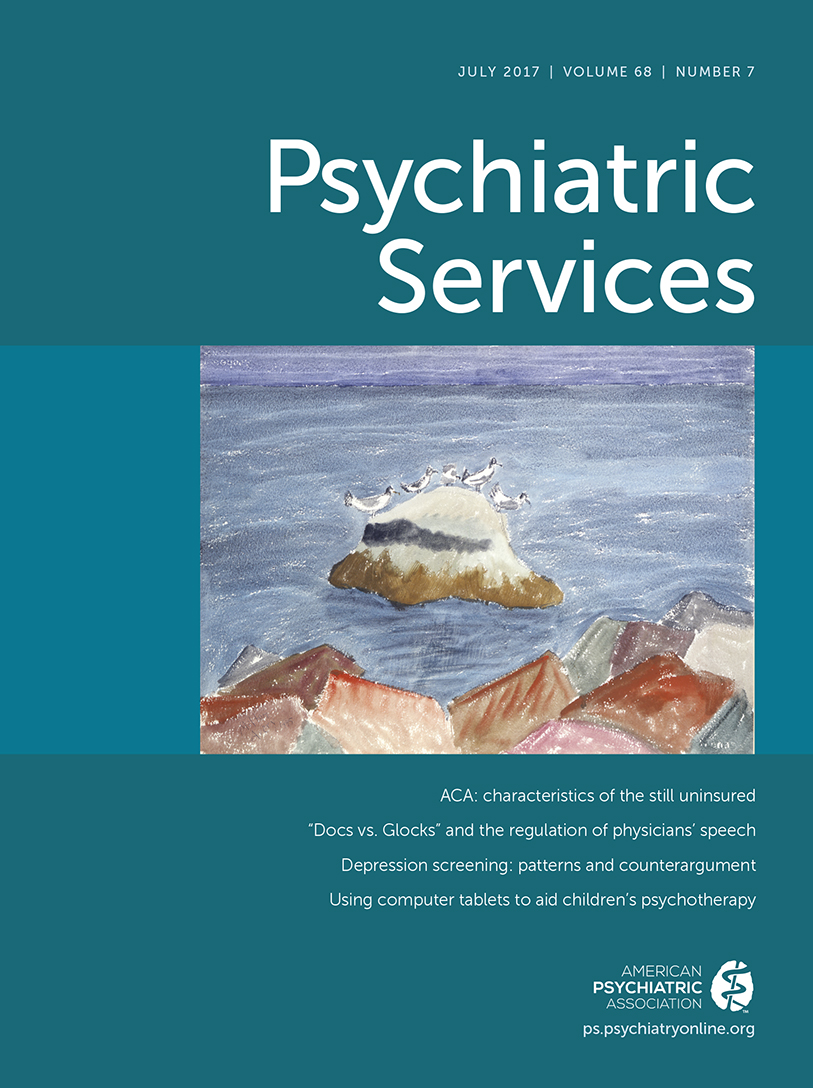The transition from adolescence to adulthood is recognized as a critical crossroads in health care by the American Academy of Pediatrics (AAP), requiring appropriate coordination to ensure that high-quality, developmentally appropriate health care services are available without interruption (
1). This transition is a noted challenge for children with special health care needs (
2). Children with autism spectrum disorder (ASD), especially those who are diagnosed as having a co-occurring general medical or psychiatric condition that requires frequent and intensive care (
3), may experience additional difficulties (
4).
The autism literature on the transition to adulthood is not well developed. Approximately one in five children with ASD receive transition-planning services, compared with 43% of other children with special health care needs (
5). However, little research has explicitly explored the change in service usage among children with ASD as they transition out of the pediatric health care system (
6). In addition, the transition from the pediatric health care system often coincides with an exit from the educational system (for example, leaving high school), where many children may receive everyday physical and mental health services (
7). This distinct transition can further affect service usage.
This study explored the health care utilization of youths ages 16 to 23 diagnosed with ASD, utilizing a nationally diverse population of privately insured youths. The study sought to determine whether utilization patterns among youths with ASD change as they transition into the adult health care system.
Methods
Data came from the Clinformatics Data Mart Database (‘Optum’; OptumInsight, Eden Prairie, Minnesota), a nationally diverse, clinically rich administrative data set of deidentified, privately insured beneficiaries spanning 2000–2013 (
http://bit.ly/2dhTl4d). The data include individuals’ full claims history during their entire enrollment period, including place of service and pharmacy prescriptions, covering approximately 55 million individuals in the United States. It was possible to link multiple visits to the same individual.
The analytic sample (16,338 individuals with 48,007 total episodes within a 12-month period) included all youths between the ages of 16 and 23 within the Optum database who had at least one inpatient or two outpatient or office claims with an
ICD-9 primary diagnosis of 299.x pervasive developmental disorder (autistic disorder, 299.0; childhood disintegrative disorder, 299.1; specific pervasive developmental disorder [PDD], 299.8; and nonspecific PDD, 299.9). This classification scheme was used in a previous study that examined a population of children with ASD in an administrative database (
8). Once a youth was identified in the sample, all claims for that youth were included for the entire time that he or she was observed in the Optum database. A binary measure was created for whether the youth was also diagnosed as having an intellectual disability (ID) (
ICD-9 codes 317.x–319.x), as indicated by one inpatient claim or two outpatient or office claims within a 12-month period. Year of birth allowed for approximating age at the time of services. The analytic sample for this study can be conceptualized as repeated cross-sections of privately insured youths with ASD.
Health care utilization was assessed across four places of service: office or outpatient setting, home setting, inpatient setting, and emergency department (ED) setting. Both the percentage of youths receiving care at a given age and the average number of visits per year were assessed. The data were modeled as cross-sectional multivariate linear regressions for each outcome in each place of service. Models were adjusted for sex, race-ethnicity (non-Hispanic white, non-Hispanic black, non-Hispanic Asian, and Hispanic), region (Northeast, Midwest, South, and West), household net worth (<$25,000, $25,000–$149,999, $150,000–$249,999, $250,000–$499,999, and ≥$500,000), year of visit, the presence of ID, and whether the insurance product was administrative services only (ASO). An ASO plan is an arrangement in which an employer hires a third party to deliver health-related administrative services to the employer, such as claims processing and billing; the employer directly bears the financial costs and risk for its employees’ health care. Because youths could have claims across years, all analyses were clustered at the individual level to account for a lack of independence between observations.
Age was modeled continuously, and interactions between age and ID were included for each place of service, drawing from differences in treatment usage seen in previous research (
9). Interactions between age and region were included when findings were statistically significant. Other interactions between age and race, net worth, and sex were tested but were not included, given that findings were not consistently significant. Estimates were calculated by using Stata, version 13.0 SE.
Results
Youths included in the sample were primarily non-Hispanic white (N=12,747, 78.0%) and male (N=12,752, 78.1%), and 15.1% (N=2,474) were diagnosed as having an ID. In addition, over one-quarter of youths lived in households with a net worth between $150,000 and $249,999 (N=4,540, 27.8%), whereas only 7.4% (N=1,217) lived in households with a net worth of less than $25,000. Most families lived in the Midwest (35.1%) or South (36.9%), with fewer families in the Northeast (14.0%) or West (13.9%) (percentages are approximate because of geographic mobility as the youth aged). [A table reporting demographic characteristics of the sample is available as an online supplement to this report.] In a given year, a majority of children received services in office or outpatient settings (98.6%), which was greater than the proportion who received care in home (9.8%), inpatient (6.6%), or ED (10.7%) settings. Likewise, youths received the most visits in office or outpatient settings (a mean of 11.22 per youth), compared with home (.82), inpatient settings (.89), and the ED (.52).
Multivariate regression results indicated the percentage of youths with ASD receiving care and the total number of visits per year decreased as youths with ASD aged [see
online supplement for yearly descriptive means]. The percentage of individuals receiving care in outpatient or office settings decreased by .19% each year (p<.001), whereas the number of visits per year in these settings also decreased (β=–.38, p<.001) (
Table 1). Youths experienced a similar decline in service utilization within inpatient settings, with a smaller percentage receiving services (β=–.32%, p<.01) and fewer visits per year (β=–.05, p<.001). Although a smaller percentage of youths received home services as they aged (β=–.14%, p<.05), the number of visits per year did not significantly decline. The use of the ED did not appear to be related to the youth’s age, with no decline noted in the percentage of youths receiving services or in the number of visits per year.
The percentage of youths with a visit in a home or inpatient setting was higher among youths with both ASD and ID compared with youths with ASD only (β=12.16% and 6.25%, respectively, p<.001 for both comparisons). Youths with both ASD and ID also had a higher number of visits per year in the home (β=2.09), outpatient or office (β=1.82), and inpatient settings (β=.69), compared with youths with ASD only (p<.001 for all comparisons). Notably, youths with ASD and ID had, on average, fewer ED visits per year compared with youths with ASD only (β=–.10, p<.05). However, there is some evidence to suggest that utilization of services decreases more rapidly among youths with ASD and ID as they age compared with youths with only ASD. The steeper rate of decline equated to an additional decrease of .22 visits per year in the outpatient setting (p<.05) and an additional .53% decrease per year in the likelihood of using inpatient services (p=.01). Youths with ID continued to have a higher amount of service utilization in the office or outpatient, home, and inpatient settings as they aged compared with youths without ID.
The results also indicate that utilization of services and the decline in utilization can vary by region. Youths residing in the Northeast used a greater quantity of office or outpatient services compared with youths living elsewhere and were more likely than youths living in the South and Midwest to utilize services in this setting (p<.001 for all comparisons). Youths in the Northeast were less likely to utilize services in the home and ED compared with youths living in the Midwest and West (p<.001 for all comparisons). Service utilization in office or outpatient settings declined faster, by an additional .38 visits per year, for youths with ASD residing in the Midwest compared with the Northeast (p<.01). Midwestern youths also experienced a faster decline in inpatient utilization compared with youths in the Northeast (β=–.57%, p<.05).
Discussion
As youths with ASD transition out of the pediatric health care system, there is a notable decline in both the percentage of youths who receive services and the total number of visits per year across multiple settings. The results also indicate an increased use of services among youths with both ASD and ID compared with youths diagnosed as having ASD only, findings that have been replicated previously in a nationally representative sample (
9). Children with both diagnoses have been found to belong to families with greater financial hardships and poorer insurance coverage than children with ASD only (
10). The faster decline in total yearly visits in office or outpatient settings and in the percentage of individuals receiving inpatient services among children with both diagnoses compared with children with ASD only may underline the challenges already faced by youths with ASD and ID.
The steady use of the ED by youths as they age may be tied to ongoing need for the services provided at these locations, especially if the ED is used as a substitute source of care as utilization declines elsewhere (
11). Significant differences by region could be tied to specific unmet treatment needs (
12), but future research is needed to further explore the mechanisms behind the geographical variation associated with service utilization.
This study presented data from a nationally drawn population of youths diagnosed as having ASD. The data provide a unique opportunity to explore the health care utilization landscape in the private insurance market. However, there were several limitations of note. The sample does not generalize to individuals covered by other private insurance carriers, nor to those receiving public services. Further, the high proportion of non-Hispanic white youths in the sample and their relatively high net worth and lower rate of ID may be a reflection of the type of individuals enrolled in the private insurance plan. The accuracy of the ASD diagnosis was based solely on claims information—clinicians may have omitted a youth’s ASD diagnosis when submitting billing information, resulting in a potential missed case in this analysis. Finally, the cross-sectional nature of the data does not allow for causal claims.
Conclusions
Although an increase in the prevalence of diagnosed ASD among children in the United States has received considerable attention recently, less attention has been paid to the possibility of an eventual corresponding increase in prevalence of adults with diagnosed ASD (
13). Our findings of significant declines in service usage among youths diagnosed as having ASD reinforce the AAP’s view that the transition from adolescence to adulthood is a critical crossroads in health care. These findings highlight the need for continued research into the transition into the adult health care system for youths with ASD, particularly those with co-occurring ID.
One possible explanation for the decline in service use could be that many practitioners of adult medicine lack specialized training to meet the unique service needs of individuals with ASD (
14). Without such training, some practitioners may feel uncomfortable treating these patients. The impact of this capability gap may be magnified by the low level of health care transition services received by youths with ASD (
15). Future research could examine the relationship between specialized training among practitioners of adult medicine and transition services for youths with ASD.

